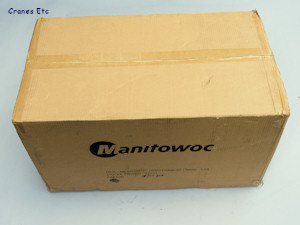 |
| Large shipping
container. |
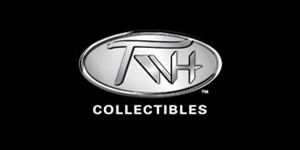 |
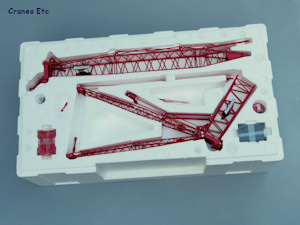 |
| Second layer.
|
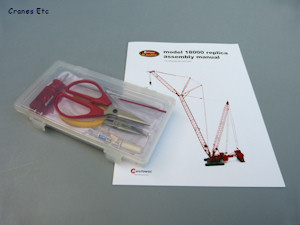 |
| Toolkit and manual. |
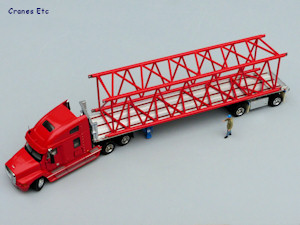 |
| Boom sections can be
used as transport loads. Here an
East flat
trailer does the carrying. |
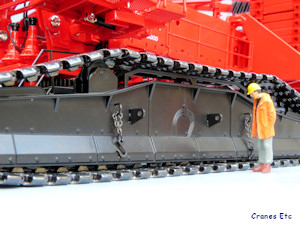 |
| Heavy track frames. |
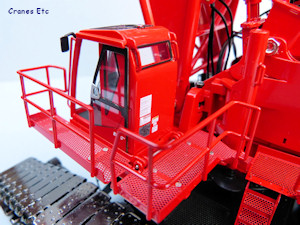 |
| Excellent detail on the
cab. |
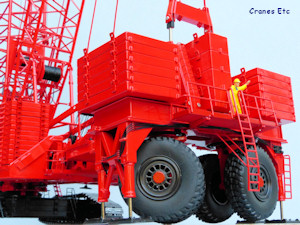 |
| Impressive tyres. |
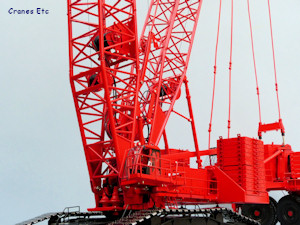 |
| Substantial boom and
fixed mast. |
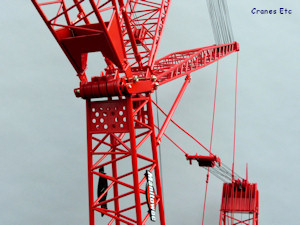 |
| Detailed lattice work. |
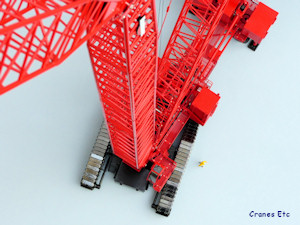 |
| The boom is very
straight in diecast.
|
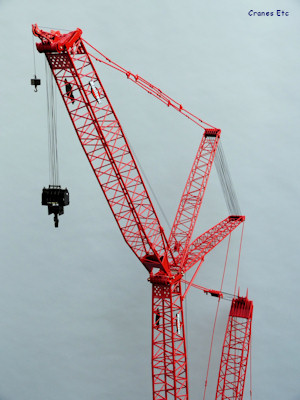 |
| The straps for the
luffing jib were not equally tensioned because of a slight twist
in the strut. |
|
 Comment on this model. Comment on this model.
The Manitowoc 18000 crawler crane can lift 750 metric tonnes
(825 US ton) when rigged with the optional MAX-ER ballast
attachment. Without it the capacity is 600 tonnes. The
maximum boom and jib combination allows lifts to around 180m
high.
This version of the model is updated from
the one introduced in 2005
with the main difference being that some of the boom sections
are diecast rather than brass.
Packaging
The model comes packed in a
very large shipping box measuring some 77 x 45
x 45cm (30 x 17 x 17in) weighing around 20kg (32lb).
Inside there is an inner white box which has a simple label on
the end and it contains three separate polystyrene trays holding the
many parts of the model.
One handrail section had become detached during shipping and was
reattached and there were a couple of fixing screws short in the
packaging.
The manual in this version of the model is different from the
first version and only consists of instructions for the model,
with no information about the real crane. The assembly instructions contain some high quality pictures of
the model including a parts list for the pieces in the box.
The only thing missing is a description of the very smallest parts
in the model, namely screws and rods used to join some of the main
pieces together. As there are subtle differences between some
of these parts a novice collector would take time trying to work
out what goes where, so a small items parts list would have assisted.
The DVD included with the first version of the model is not
included with this one, but the excellent toolkit is included.
It consists of scissors, pliers, screwdriver and tweezers as
well as a couple of needles for reeving and a pair of cotton gloves.
The kit also includes a tool for operating winches in the crane
body. The main box also
includes a few spare crawler track links.
The assembly of the model is straightforward although the fit of
some of the parts is tight. Much of the model is
pre-assembled in the box but still quite a number of hours is
required to fully erect and reeve the model.
Detail
This model is very detailed. The undercarriage and crane body
are permanently assembled as one piece and although an experienced
modeller might want to have a go at taking it to pieces, it is obviously
not intended for this. The tracks are metal, and excellent,
and the frames are finely detailed with rivets and include a couple
of chains with hooks. Black counterweight slabs fit into
trays slung from the under frame. These are well made and
are complete with lifting eyes.
The operator's cab is fully detailed with windscreen wipers,
grab handles and an unsilvered door mirror. It has a
detailed interior complete with the 'Manitowoc' logo printed on
the back of the seat. At the rear of the cab various notices
are replicated with tiny writing.
The handrails and platforms around the model are metal and
finely crafted.
At the front of the crane body two fine slewing motors are modelled
complete with hydraulic hoses leading from their tops, and there
are connection points for hydraulic hosing from the drums on the
boom and fixed mast. Four hydraulic jacks which would be used
for self-unloading are modelled provided and they slot into lugs
on the crane body.
At the rear counterweight trays
hang off each side and they have one slab permanently fixed in
each tray. The slabs include step irons to replicate the ladder formed to allow
slinging and unslinging.
An engine block is present inside the body and is complete with a
rotating fan inside a radiator
assembly.
Hydraulic oil and fuel tanks are also modelled and it is here that
some of the few plastic parts are found in the shape of exhaust
pipes and pipe work.
The boom and jib sections of the crane are
a combination of brass and diecast elements.
The diecast boom sections are perfectly straight which is an
improvement over the original model. However some of the
more unique sections appear to still be brass as they are not
geometrically perfect with implications for how the straps look
when the model is erected as tensions become unequal.
The whip line extension
at the end of the luffing jib had a clear twist.
The connections are positive screw joints so there is no fear of
the model collapsing, and the straps are metal and easily bent. Included detail such as winches are
very good and are complete with hydraulic hosing which connects
through into the main crane body. Pulleys on the model are
first rate as they have spokes and turn freely on their axles.
The boom and jib head have plastic 'Manitowoc' sign boards.
The MAX-ER attachment carries additional
counterweights and it comes as a single item so does not make a
viable transport load. The walkways and handrails are
excellent and the step irons up the frame to the strap connection point are also impressive. There is some
very good hydraulic hosing detail on the legs and the tyres are
very good heavy rubber versions. The hydraulic rams for lifting
the frame up have metal pistons and pads. The numerous
counterweight slabs provided are the same high quality as those
used on the crane body.
Two hooks are supplied. The main block is large piece with
15 pulleys and a very good swivelling double hook. The whip
line is a single metal piece.
Features
The crawler tracks roll extremely well even on a smooth surface
and are tensioned by spring-loaded idlers in the track frames.
The four jacks have pads which can be unscrewed but because of
the way the jacks are fixed, they cannot lift the machine.
The cab tilts and also has a neat sliding door.
The MAX-ER attachment has wheel assemblies which rotate to allow
the unit to be towed, or to move in a circle when the crane rotates.
The pendant connections at the top of the MAX-ER are spring loaded
in order to ensure tension in the straps.
The crane rotates well under load.
To operate the model a tool is provided for the winches in the
crane body. The winch drum for the moving mast has a good
working brake mechanism. When the tool is pushed in, the drum
presses against a spring and away from a brake surface such that
it turns freely when the tool is turned. This is a fine system
but actually it is unnecessary on the model as supplied since
the moving mast is permanently riveted into its operating
position. The other drums are all free rolling with no brake
whatsoever and it is a surprise this issue has not been
addressed on this revised version of the model.
The model has been designed to be erected in its full
configuration and in places connections are riveted and this
prevents the model being displayed in other configurations such
as without the jib. It appears it would have
straightforward to make minor amendments to the model to make
this revised version more flexible but the opportunity has not
been taken.
Quality
The quality of the casting is pretty much first class with very
fine detail appearing throughout the model. Some of the lattice
work was not perfect on the review model.
The paintwork and graphics are very good throughout.
Price
This model is good value overall given the size and quality of
what is offered.
Overall
TWH hit the mark in terms of a 'museum quality' model because of
the high level of detail and the 18000 looks great.
However in terms of functionality this version is not an
improvement on the previous version because of the loose winches
and restricted configuration possibilities. Overall it
remains an outstanding detailed model.
Footnotes
The first version of the
model appeared at the Nuremberg Toy Fair in February 2005 and
was delivered later that year. This revised version was
made in a run of 300 models in 2012.
|
|
|
|
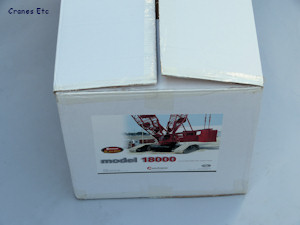 |
| Plain inner box. |
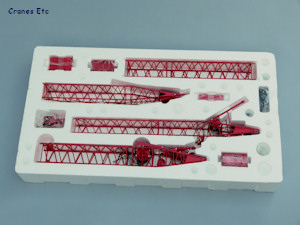 |
| Top layer. |
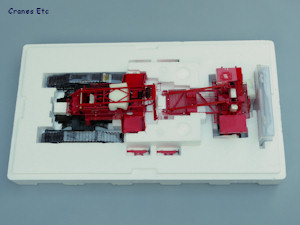 |
| Bottom layer.
|
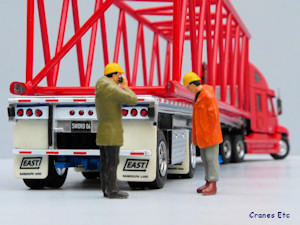 |
| Straight diecast boom
section. |
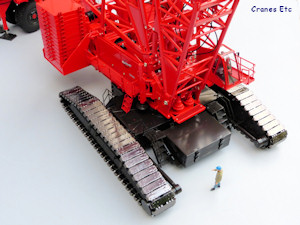 |
| A complicated and
detailed model. |
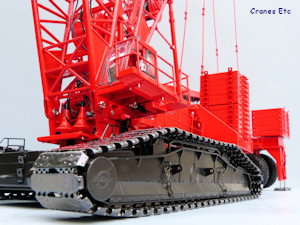 |
| A large and heavy
model.
|
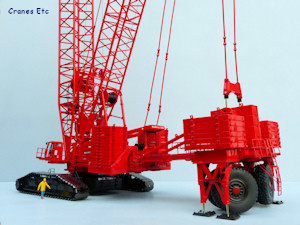 |
| MAX-ER with its pads
down. |
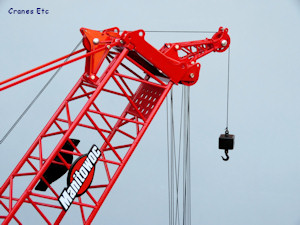 |
| Single
line hook on the whip line. |
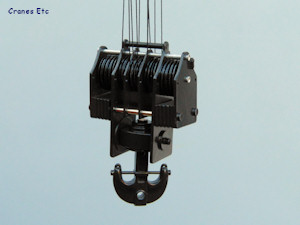 |
| Heavy main hook.
|
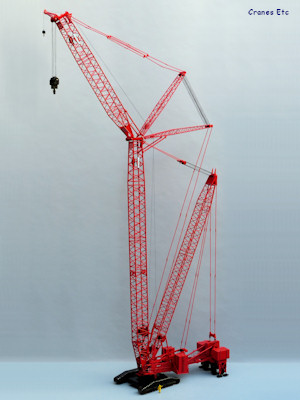 |
| Fully erected it is a
very impressive model. |
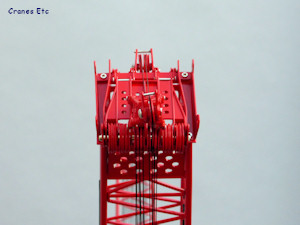 |
| Luffing jib head.
Whip line head geometry is twisted
and poor. |
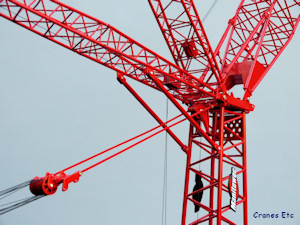 |
| Fixed strut has one
riveted connection preventing a non-luffing configuration being
built. |
|

